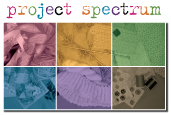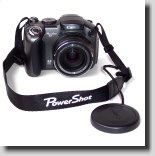
The next stage of Celtic Moon involved felting the land piece. After backing it with stabilizer, I followed the lines of the print and felted wool roving here and there, using three different shades of green. I then positioned the piece on the background and prepared my sewing machine for free motion quilting.

There are several items that I find helpful for machine quilting. Of course, good quality quilting needles are important. I also attach a straight stitch plate to my machine, which results in nice stitches on the back of the quilt. Sometimes I use quilting gloves (usually in the winter) and other times I prefer the banker’s tips sold in office supply stores. A newer item that I really like is the free motion slider, a Teflon sheet that allows the quilt to move freely under the needle.

I chose a 35 wt. variegated cotton thread and quilted the land piece, following the general shapes on the print. Next, I picked out another variegated thread for the water and quilted it quite densely. The marble design made the quilting quite easy since it already resembled the flow of water. When the quilting was complete, I stitched around the Celtic garnet stitch design, which gave it the look of trapunto.
The final stage of the quilt made me a little nervous. I had thought of several ways I could put a moon on the surface, but finally decided to use chiffon and a heat gun since it allowed for the background to show through and also rendered the look of the moon’s craters.
Since chiffon shifts easily, I pinned my pattern on top of it and then cut around it, leaving plenty of fabric around the edges. I then sewed around the moon pattern.

Next, I repeated the method had I used for the Celtic design, only this time I made my circles much larger. When I completed the garnet stitches, I trimmed off the excess fabric.

I took the quilt outside and used a heat gun to melt the holes in the chiffon. As soon as the holes would begin forming, I would move the heat gun to the next area. This is a technique that takes practice and demands careful attention. You can easily burn your fabric if you’re not careful. If you try this method, do a test sample first so that you know how close to position your heat gun to your fabric.
To complete the moon, I painted outlines with Lumiere metallic bronze around the burned out holes.

This certainly isn’t the most colorful quilt I’ve every made, but the techniques used to construct it made it a very interesting project. I hope you will try some of the methods and incorporate them into your projects.
~~~~~~~~~~~~~~~~~~~~~~~~~~~~~~~
N. Rene West
Time Treasured




















